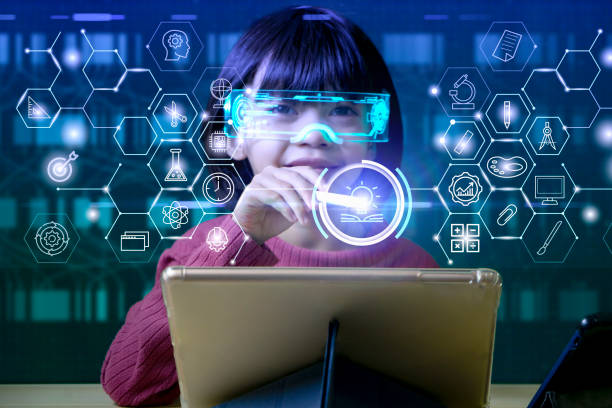Artificial Intelligence (AI) is no longer a distant concept from sci-fi movies, it’s here, and it’s changing the way students learn. In classrooms across the globe, AI in K–12 education is transforming lesson plans, customizing learning experiences, and helping teachers make smarter decisions.
From adaptive learning platforms to AI-powered tutors and behavior-predicting software, the educational landscape is evolving faster than ever. But what does this mean for students, teachers, and parents? Will AI replace educators or empower them?
This guide explores the future of AI in K–12 education, what tools are already in use, and how we can expect the classroom to evolve in the coming years.
What Is AI in K–12 Education?
Artificial Intelligence (AI) in education refers to technologies that simulate human thinking to enhance learning. In K–12 settings, AI supports:
- Personalized learning paths
- Automated grading
- Behavior tracking
- Virtual tutors
- Curriculum recommendations
According to McKinsey, AI could reduce teacher workloads by 20–40%, freeing up time for one-on-one student engagement.
How AI Is Already Impacting K–12 Classrooms
1. Personalized Learning at Scale
AI platforms like Khanmigo or Squirrel AI adapt to each student’s pace, knowledge gaps, and learning style. This real-time personalization ensures that no student is left behind—or held back.
Benefits of AI-driven personalization:
- Improves comprehension and retention
- Reduces boredom or frustration
- Supports differentiated instruction
2. AI Tutors and Homework Help
AI chatbots and voice assistants now help students with math problems, writing assignments, and science questions—24/7. Tools like ChatGPT, Photomath, and Jasper AI are leading this transformation.
3. Smart Assessment and Feedback
Grading large numbers of essays or assignments can be time-consuming. AI tools now analyze student responses and offer immediate, data-driven feedback—often with suggestions for improvement.
Use cases include:
- Automated essay scoring
- Real-time quiz results
- Feedback on writing mechanics and style
This kind of instant feedback empowers students to reflect and revise, building growth mindset.
Benefits of AI in K–12 Education
| Benefit | Description |
|---|---|
| Efficiency | Automates grading, attendance, and reporting |
| Equity | Adapts to each student’s learning needs |
| Engagement | Offers interactive and gamified experiences |
| Insights | Helps teachers analyze trends in student performance |
| Accessibility | Supports special education with speech-to-text and language translation |
AI in K–12 classrooms is not about replacing teachers it’s about amplifying their impact.
Challenges and Concerns with AI in Education
1. Data Privacy and Student Surveillance
Many parents and educators worry about the data AI tools collect. Who owns it? How is it used? Protecting student privacy must be a top priority.
2. Algorithmic Bias
AI is only as unbiased as the data it’s trained on. If the data reflects inequality, so will the outcomes. Educators must be trained to spot and address algorithmic bias.
Real Example: Facial recognition tools have shown higher error rates for students of color—a clear sign that ethical guardrails are needed.
3. Teacher Training and Readiness
While AI can make teaching easier, there’s a learning curve. Teachers need ongoing professional development to:
- Understand how AI tools work
- Integrate them effectively
- Evaluate their impact
The Future: What’s Next for AI in K–12?
Predictive Analytics
Future AI systems may predict student dropouts, flag early signs of disengagement, or even recommend interventions before problems arise.
AI-Powered Virtual Classrooms
Imagine a future where students explore the solar system using AI-guided VR simulations, or practice public speaking with real-time AI feedback.
This immersive learning isn’t far off—it’s already in pilot programs across the U.S.
AI-Driven Parent Communication
Parents could receive AI-generated insights on their child’s progress, mood, and classroom engagement, allowing for better home-school partnerships.
Case Study: AI in Action
Location: Gwinnett County Public Schools, Georgia
Tool: AI-driven learning platform from DreamBox
Results:
- 16% increase in math proficiency
- 91% of students reported enjoying learning more
- Teachers gained 3–5 hours weekly in planning time
This real-world example shows how AI in K–12 can create measurable improvements in both academic and emotional outcomes.
The Role of Educators in an AI World
No matter how advanced AI becomes, the human touch in education remains irreplaceable. Teachers provide:
- Emotional support
- Cultural context
- Ethical guidance
- Real-world judgment
The goal is to blend AI with human expertise, not replace it. Think of AI as the co-pilot, with educators in the captain’s seat.
Read Also: 10 Essential K–12 School Safety Tips Every Parent Should Know
Conclusion
The future of AI in K–12 education is filled with promise and responsibility. When used wisely, AI tools can create more personalized, equitable, and efficient classrooms. But challenges around privacy, bias, and implementation must be addressed with care.
As AI continues to evolve, the most successful schools will be those that balance innovation with empathy, and technology with trust. Teachers won’t be replaced they’ll be empowered.
If you’re a parent, educator, or policymaker, now’s the time to learn, adapt, and guide this transformation to ensure it benefits every student.
FAQs
1. Will AI replace teachers in K–12 schools?
No. AI supports educators by automating tasks, but teachers are essential for emotional and ethical guidance.
2. How does AI personalize learning for students?
AI analyzes student performance in real time to adjust content difficulty, pace, and learning style.
3. Are AI tools safe for student data?
Reputable tools comply with FERPA and other privacy laws, but schools must ensure proper safeguards.
4. What are the most common AI tools in classrooms?
Examples include ChatGPT, DreamBox, Khan Academy’s AI tutor, and tools for grading or language support.
5. How can teachers get started with AI?
Begin with training workshops, free tools, and pilot programs. Start small then scale based on results.
